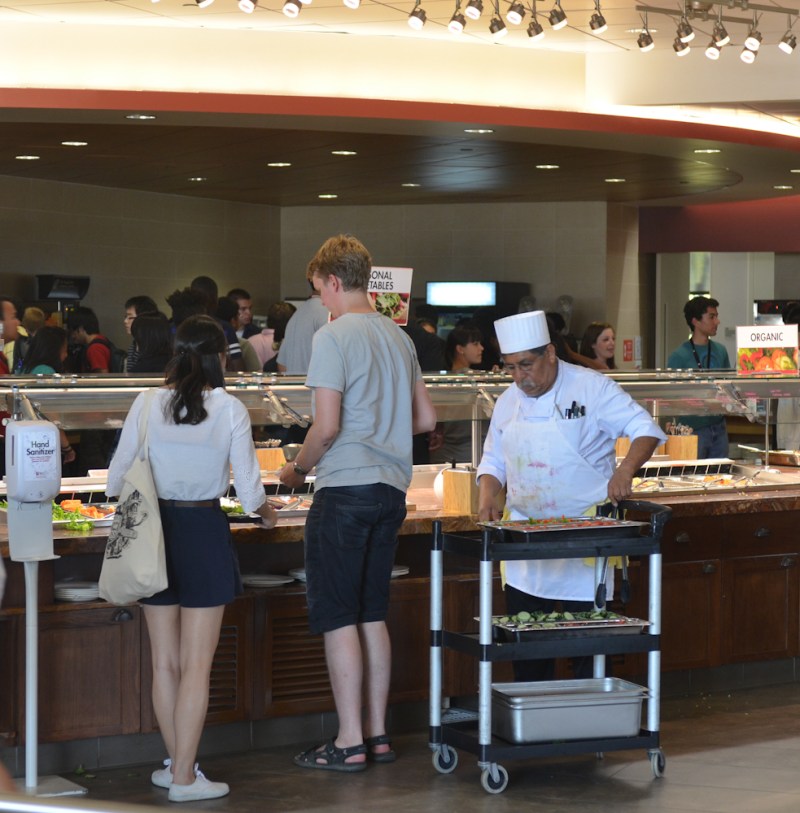When the Stanford meal plan costs $5,889 per year, we’d better hope we’re getting our money’s worth. Yet when many students report wasted meal swipes or meal plan dollars, we often get the sense that our money is disappearing down a deep, dark hole.
For that $5,889, we can choose between 19 meals per week and zero Meal Plan Dollars (MPD), or 14 meals per week and $155, $135, and $130 MPD for Fall, Winter, and Spring Quarter respectively. Freshmen are at a particular disadvantage, because unlike upperclassman, we cannot opt for the meal plan option that allows ten swipes per week and $270, $245, and $235 MPD per quarter.
When I surveyed 34 different freshmen in the class of 2020, responses to the food plan were mixed.
“The dining hall hours are designed to edge people out of breakfast, eat [dinner] absurdly early and force them to spend meal plan dollars on Late Night; when they run out [of MPD] students have to use credit cards and provide more money for the university,” wrote one freshman.
All freshmen are required to purchase a meal plan, along with any student living on campus in Branner, Crothers, Flomo, Lag, Gerhard Casper, Ricker, Roble, Stern, Toyon, Wilbur, Murray, Yost and East (the majority of undergraduate housing outside Suites, Mirrielees and the Row). Stanford’s Residential and Dining Enterprises argues that this requirement is to encourage student bonding, stating on their website:
“Mealtimes play a key role in helping to build a sense of community within a house and in promoting interaction between residents, faculty and guests. For this reason, all students living in an undergraduate residence must purchase the meal plan offered by their residence. In most cases, this is a R&DE Stanford Dining Meal Plan.”
In addition to encouraging camaraderie, students praised the affordability of the meal plan options — all you can eat food! And it makes students of all economic backgrounds feel more welcomed because they don’t have to worry about affording astronomical Palo Alto dinner prices when practically everyone eats in the dining hall for dinner most nights.
However, is the meal plan really so cost-effective?
One student noted that for the $5,899 paid per year, we’re really not eating enough food to actually be worth that amount. Although first I was skeptical of this assertion, I calculated the amount of money we spend on food each meal, assuming we’re at Stanford about eight months (nine months, but subtract three weeks for winter break, one week for Thanksgiving, one week for Spring Break, plus most students aren’t here for the entirety of all three finals weeks) and eat three meals a day.
We end up paying more than $8 for each meal at Stanford. Considering the quality of food — and the fact that we could be making ourselves much better food if we could just opt out of the meal plan and cook for ourselves — that’s a little disquieting. For comparison, the salads at CoHo are mostly $6.95 — you could be buying yourself something from CoHo three meals a day and be spending less money than the Stanford Meal Plan.
About a third of students complained about the timing. Most of the dining halls have breakfast hours from 7:30-9:00 a.m. in the morning, lunch from 12:00-1:30 p.m. and dinner from 5:00-7:00 p.m. As someone who ate dinner at 8:30 or 9:00 p.m. back home, it was quite a shock transitioning to the dining hall hours at first!
Worst, on the weekends, brunch does not open until 10:30 a.m. Which means if you’re an early riser, you have to spend your own money on other options (or just wait, hungrily, until 10:30am).
Of course, there’s Arrillaga Dining, which has much more flexible hours. But remember the inclusivity and camaraderie that R&DE boasted of? That’s all lost when a student goes to Arrillaga, which will invariably be filled with hundreds of students from other random dorms you don’t know.
Students also complained about the lack of food options in the dining hall and with Meal Plan Dollars, especially since only eight places on campus accept MPDs. Eight may sound like a lot, but when one of them is an ice cream place and most of the others only sell greasy, late night treats, there aren’t a lot of opportunities to use your MPDs outside Olive’s or Heirlooms. And if you don’t use all your MPD by the end of the quarter, all but fifty Meal Plan Dollars just go down the drain. Same with unused meal swipes at the end of the week.
Another issue that arises is for students with food restrictions. Stanford has done a good job in recognizing students with peanut allergies – it recently introduced peanut-free dining at Ricker Dining hall to meet the needs of severely allergic students.
However, Stanford R&DE Dining struggles to accommodate other dietary needs. Dishes are often mislabeled or do not include the full list of ingredients. In addition, students want more options for vegetarian and vegan students. Finally, students with other serious allergies — such as celiac disease – complained about issues of contamination in the dining hall.
One third of students even say that they wouldn’t choose to have a meal plan, despite the inconvenience of cooking and purchasing their own groceries. Other students qualified it, wishing they could have fewer swipes, fewer Meal Plan Dollars or more dining halls with flexible eating hours.
Contact Caroline Dunn at cwdunn98 ‘at’ stanford.edu.
